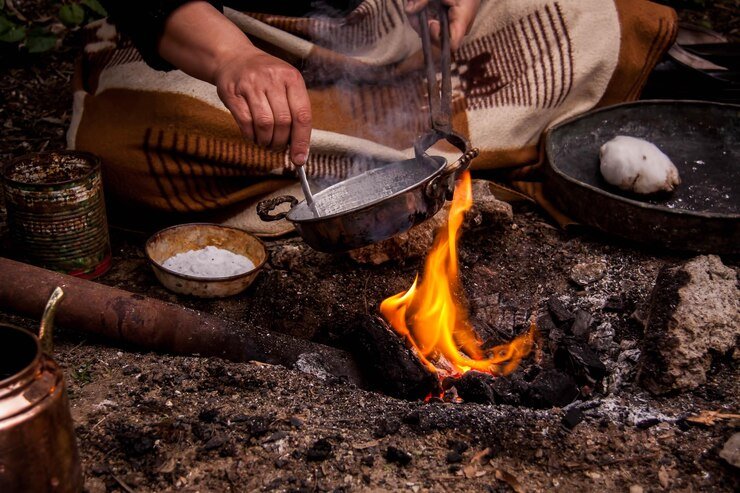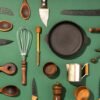Flames That Fed the World
Close your eyes and picture it: a smoky medieval kitchen, fire crackling in a hearth, a heavy iron cauldron hanging on a hook, and the scent of bread baking on warm stones. Before gas stoves, microwaves, or fancy appliances, food was cooked over flames. The history of open fire cooking isn’t just about survival; it’s a story of culture, flavor, and the medieval kitchen tools that made it all possible.
Even today, cooking over fire has a magic that stoves can’t quite replicate. Whether it’s camping with friends or enjoying a barbecue, the appeal of fire-cooked food never goes away. But back in the Middle Ages, this wasn’t a choice it was the only way to cook.
Why Open Fire Cooking Matters
When you step back in time, it’s easy to see why fire was the center of the kitchen. It wasn’t just about food; it was about life. The hearth provided heat, light, and a gathering space. Families huddled around flames to eat, talk, and even tell stories. That’s why medieval kitchen tools were designed to adapt to the fire: long-handled ladles, roasting spits, and iron pots that could withstand the heat.
Culturally, fire represented more than survival. In some traditions, it was sacred. Ancient Europeans, like the Romans and Celts, believed the hearth fire connected them to their gods. Medieval households kept their fires burning constantly, not only to cook but also to preserve the soul of the home.
Medieval Kitchen Tools for Fire Cooking
The tools of open fire cooking were surprisingly clever, even if simple by modern standards. Here are some that stood the test of time:
Iron Cauldrons and Pots
These heavy vessels could be placed directly on embers or hung above flames. Stews, broths, and porridges simmered slowly, feeding whole families. Our modern cast-iron Dutch ovens trace their roots directly to these medieval cauldrons.
Roasting Spits
Picture a knight’s feast: whole boars or chickens rotating slowly on a spit. This medieval kitchen tool eventually evolved into today’s rotisserie ovens.
Griddles and Baking Stones
Flat breads and pies were baked on heated stones long before the invention of ovens. If you’ve ever used a pizza stone, you’ve participated in a medieval tradition.
Wooden Spoons and Ladles
Even in fire kitchens, cooks needed tools to stir bubbling pots and serve food. Wooden utensils were perfect—heat-resistant and long-lasting.
Tripods and Iron Racks
Ingenious supports that let pots hang over flames or rest just above glowing embers. Campers still use modern versions today.
Table: From Fire to Kitchen Tool Evolution
| Medieval Tool | Function in Open Fire Cooking | Modern Equivalent |
|---|---|---|
| Iron Cauldron | Stews, soups, porridges | Dutch oven / Stockpot |
| Roasting Spit | Turning meat over the fire | Rotisserie / Grill |
| Stone Baking Slab | Baking bread and flatbreads | Pizza stone / Brick oven |
| Wooden Spoon / Ladle | Stirring soups, sauces | Wooden / Silicone spoon |
| Tripod / Fire Rack | Holding pots above flames | Camping tripod, oven rack |
The Experience of Fire Cooking
If you’ve ever cooked over a campfire, you know it’s both challenging and rewarding. The smell of smoke, the uneven heat, the crackling wood—it feels primal. I once tried making bread in a clay pot over an open fire. The crust came out smoky and crisp, with a flavor no modern oven could replicate. It was messy, a little unpredictable, but unforgettable. That unpredictability is exactly what medieval cooks lived with daily.
Surprisingly, even modern chefs admire the technique. Some Michelin-starred restaurants now incorporate open fire pits to add authenticity and complexity to their dishes. What medieval peasants considered normal, we now call gourmet.
Historical Insights
Archaeologists and historians agree: open fire cooking was humanity’s first “technology.” According to Smithsonian studies, controlled fire use dates back nearly a million years. By the Middle Ages, kitchens were organized entirely around the hearth.
Texts like Le Ménagier de Paris (1393) describe recipes that involve roasting, boiling, and baking directly over flames. National Geographic notes that many medieval recipes would feel oddly familiar today—soups, roasts, and breads made with tools we still recognize.
The continuity is fascinating. It means when you grill a chicken or bake sourdough on a stone, you’re echoing centuries of food history.
Why Fire-Cooked Food Still Appeals
So why do we still crave fire-cooked meals in an age of induction cooktops and air fryers? The answer is layered:
-
Flavor: Smoke adds depth that machines can’t replicate.
-
Connection: Fire connects us to ancestors and traditions.
-
Simplicity: It strips cooking down to its essence.
-
Community: Fires draw people together.
Barbecues, pizza ovens, and fire pits aren’t just about cooking—they’re about reviving something deeply human.
Challenges Medieval Cooks Faced
Of course, romantic as it sounds, medieval fire cooking wasn’t easy. Cooks had to deal with:
-
Smoke fills the room, often without chimneys.
-
Uneven heat that could burn food in seconds.
-
Hours of manual labor tending flames.
Yet, the skills they developed turned into traditions we still honor. In fact, the patience and watchfulness required shaped cooking into an art, not just a task.
What This Really Means
When you step back, the history of open fire cooking isn’t just about food—it’s about identity. Medieval kitchen tools weren’t primitive; they were ingenious. They gave us the foundation of modern cookware, and more importantly, they remind us that food isn’t just fuel. It’s a connection.
The next time you roast marshmallows, grill burgers, or simmer stew in a cast-iron pot, remember: you’re part of a story as old as civilization itself.
FAQs About Open Fire Cooking
Q1: What was the most common medieval cooking method?
Boiling and stewing in cauldrons over open fires were most common, since they stretched food for large households.
Q2: Do people still cook this way today?
Yes. From African clay-pot cooking to Italian wood-fired pizzas, fire remains central in many traditions.
Q3: Why are medieval kitchen tools still relevant?
They’re durable, effective, and many designs (like pots, spits, and stones) became the prototypes of modern cookware.



